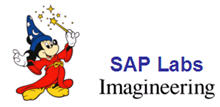SAP's cautious Web 2.0 imagineering


However, SAP takes a very conservative approach to commercializing and mainstreaming the imagineering from Browne's group.
Widgets and social networking aren't exactly revolutionary at this point, but Browne is cautious about introducing these tools to employees and customers, "We have to be careful how we introduce new technology. We don’t want to create a headache for IT organizations." Headache meaning it's not managed, secure and compliance. Yet, widgets are social networks flooding through the back doors of enterprises.
Browne's time horizon for introducing new technologies is 18 to 24 months, which is a snail's pace compared to companies addressing consumer audiences.
Browne's group has made progress in developing Harmony, a social network behind the firewall. "The $64 million question is will social networks work in the enterprise and what is the secret sauce," Browne said regarding social networks. Harmony was first introduced on April 10 to SAP Labs users in North America. So far, 1,000 of the 1,700 SAP Labs employees have signed up for Harmony and 10 to 13 percent use it every day.
"We need to weave it into the fabric of all mission critical applications in the enterprise, so its relevant and available when they need," Browne said. He gave an example of integrating social networks with SAP's CRM and HR applications, allowing employees to have more control over what information is propagated about themselves in the organization. Harmony, for instance, can surface more color about the person and their expertise, creating an interaction between Harmony and the HR system, with end user and company created content.
So far, Harmony usage is more social than professional. Members have created 136 groups, such as photography and yoga. The groups formed on Harmony led to the establishment of a quiet room for yoga and ping pong tables. "[Without Harmony] the company wouldn't have know about those needs," Browne said. "Now we are buying ping pong table for the Palo Alto campus."
Ping pong tables is modest evidence of some utility for enterprise social networks, but it won't sell any CEOs on the concept and neither is Browne. "We have a small team and we are in the imagineering phase. [Harmony] may never turn into a product. We are actively trying to roll it out globally to employees, but there are cultural, language, security and legal issues, such as does the company own data employees contribute.
Larry Dignan posted about his conversation with executives from Trampoline Systems, one of the companies that is commercializing social networking for enterprises while SAP imagineers. They agreed with Browne that culture, security, manageability, integration with group policies and privacy are challenges.
In addition, explaining social networking remains a hurdle to adoption. “From where I sit probably the hardest part is that there isn’t vocabulary to describe it really. Social networking for the enterprise makes most people in the enterprise cringe, but we also have to explain it more clearly than enterprise 2.0," said Peter Biddle, vice president of development at Trampoline.
On the other hand, social networks offer a far better way to leverage resources within a company, such as finding people who have expertise in a particular area. It's also a way to bridge the generation gap, giving those entering the workplace a familiar tool and interface and the older generation a way to connect and share knowledge.
SAP's widget platform for delivering data on desktops, mobile devices and in browsers. Browne described SAP's widget effort "iTunes for the enterprise." The company plans to create a gallery of widgets interfaces and already has delivered an Eclipse plug-in for developing widgets to the SAP Developer Network.
Currently, SAP is testing widgets internally, but has no plans to roll them out to customers any time soon. "It takes a long time to navigate through SAP and determine if it's a viable business for us to enter. We need to ensure that customers want it and understand the impact the environment, such as support, could have on us," Browne said. "It doesn’t fit the norm in the way SAP has done business. The approach of an entire collection of componentry and elements is new to SAP as well as how we are going to market with it."
He went on to explain that SAP cannot "disrupt the core" of 40,000 customers where SAP is deeply embedded with next generation applications and technologies. "No company could do it in a swift manner. It would be dangerous for the user base."
It's understandable that SAP should be cautious in introducing new technologies, especially concepts like social networking that are early in their maturation phase and difficult to explain to executive management, unless they are under 30 years old. Yet, I can't help but think that SAP has its head partially in the sand. It certainly has the resources to be at the forefront of the next generation of applications, just not the mindset. It makes you wonder how revolutionary SAP's A1S product can be given the conservatism of the company.